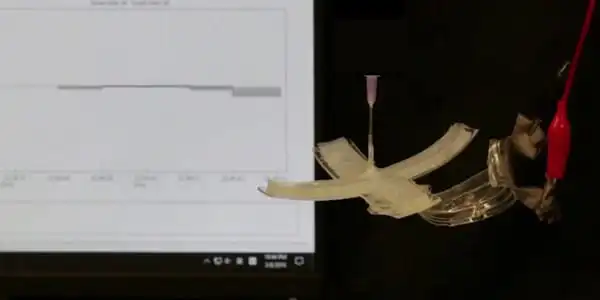Soft sensors that can stretch and twist with the device or wearer will be required in the future generation of soft robotics, smart clothes, and biocompatible medical equipment. The difficulty is that most of the components used in traditional sensing are stiff. Researchers have created a self-powered soft thermometer that can be integrated into stretchable electronics and soft robots.
Soft sensors that can stretch and twist with the device or wearer will be required in the future generation of soft robotics, smart clothes, and biocompatible medical equipment. The difficulty is that most of the components used in traditional sensing are stiff.
Harvard John A. Paulson School of Engineering and Applied Sciences (SEAS) researchers have developed a soft, flexible, self-powered thermometer that may be integrated into stretchable electronics and soft robots.
We have developed soft temperature sensors with high sensitivity and quick response time, which opens up new possibilities for creating new human-machine interfaces and soft robots in healthcare, engineering, and entertainment.
Professor Zhigang Suo
A soft-bodied robot cannot have any hard, inflexible components in order to be completely soft. As a result, soft batteries, circuitry, and actuators have already been seen. A squishy, stretchable thermometer has now been added to that list. The self-powered gadget, which is currently in development at Harvard University’s John A. Paulson School of Engineering and Applied Sciences, is composed of three layers: an electrolyte solution, an electrode, and a dielectric (non-conductive) material that separates the two.
“We have developed soft temperature sensors with high sensitivity and quick response time, which opens up new possibilities for creating new human-machine interfaces and soft robots in healthcare, engineering, and entertainment,” said Zhigang Suo, the Allen E., and Marilyn M. Puckett Professor of Mechanics and Materials at SEAS and the paper’s senior author.
The findings are reported in the Proceedings of the National Academy of Sciences. The thermometer is made up of three simple components: an electrolyte, an electrode, and a dielectric substance that separates the two. Ions collect at the electrolyte/dielectric contact, while electrons accumulate at the dielectric/electrode interface. An ionic cloud forms in the electrolyte as a result of the charge imbalance between the two. When the temperature varies, the thickness of the ionic cloud changes, and a voltage is generated. The voltage is sensitive to temperature but insensitive to stretch.

“Because the design is so simple, there are so many various ways to tweak the sensor depending on the application,” said Yecheng Wang, the paper’s first author and a postdoctoral scholar at SEAS. “You can use various materials, organize them in various ways, and optimize them for various jobs.”
The researchers created four temperature sensor devices by assembling the electrolyte, dielectric, and electrode in various configurations. In one experiment, scientists built the sensor into a soft gripper and used it to measure the temperature of a hot hard-cooked egg. The sensors are more sensitive than typical thermoelectric thermometers and can detect temperature changes in as little as 10 milliseconds.
Ions accumulate at the interface between the dielectric material and the electrolyte, whereas electrons accumulate at the dielectric material-electrode interface. This induces an imbalance in the electrical charge at the two interfaces, which results in the formation of electrochemical phenomena known as an ionic cloud in the electrolyte.
When the temperature around the thermometer changes, so does the thickness of the ionic cloud, leading the electrode to generate an electrical current. Because the strength of that current varies with temperature but is unaffected by stretching or compressing the thermometer, it serves as an accurate and precise measurement of the ambient temperature.
So far, studies have shown that the soft thermometer is more sensitive than a typical thermoelectric thermometer, reacting to temperature changes in less than 10 milliseconds. Furthermore, depending on the materials used in their manufacture, several variants of the thermometer could measure temperatures as high as 200 oC (392 oF) and as low as -100 oC (-148 oF).
“We showed that these sensors can be made compact, stable, and even transparent,” Wang added. The thermometer may measure temperatures as high as 200 degrees Celsius or as low as -100 degrees Celsius, depending on the materials employed. “This highly adaptable platform has the potential to usher in new technologies to enable and better the internet of everything and everyone,” Suo added.
















